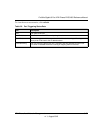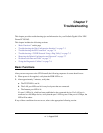
ProSafe Gigabit 8 Port VPN Firewall FVS318G Reference Manual
Troubleshooting 7-7
v1.1, August 2010
– If your ISP assigned a host name to your PC, enter that host name as the Account Name on
the Broadband ISP Settings screen (see Figure 2-2 on page 2-4).
– Your ISP could be rejecting the Ethernet MAC addresses of all but one of your PCs. Many
broadband ISPs restrict access by only allowing traffic from the MAC address of your
broadband modem, but some ISPs additionally restrict access to the MAC address of a
single PC connected to that modem. If this is the case, you must configure your VPN
firewall to “clone” or “spoof” the MAC address from the authorized PC. You can do this
on the Broadband Advanced Options screen (see Figure 2-10 on page 2-13).
Restoring the Default Configuration and Password
This section explains how to restore the factory default configuration settings, changing the VPN
firewall’s administration password to password and the IP address to 192.168.1.1. You can erase
the current configuration and restore factory defaults in two ways:
• Restore the VPN firewall to factory default settings from the Settings Backup and Firmware
Upgrade screen (see “Reverting to Factory Default Settings” on page 6-20).
• Use the reset button on the rear panel of the VPN firewall. Use this method for cases when the
administration password or IP address is not known.
To restore the factory default configuration settings without knowing the administration password
or IP address, you must use the Factory Defaults button on the rear panel of the VPN firewall.
To restore the factory defaults:
1. Press and hold the Factory Defaults button until the Test LED turns on and begins to blink
(about 10 seconds).
2. Release the reset button and wait for the VPN firewall to reboot.
Problems with Date and Time
The Time Zone screen (select Administration from the main and Time Zone from the submenu)
displays the current date and time of day. The VPN firewall uses the Network Time Protocol
(NTP) to obtain the current time from one of several Network Time Servers on the Internet. Each
entry in the log is stamped with the date and time of day.


















